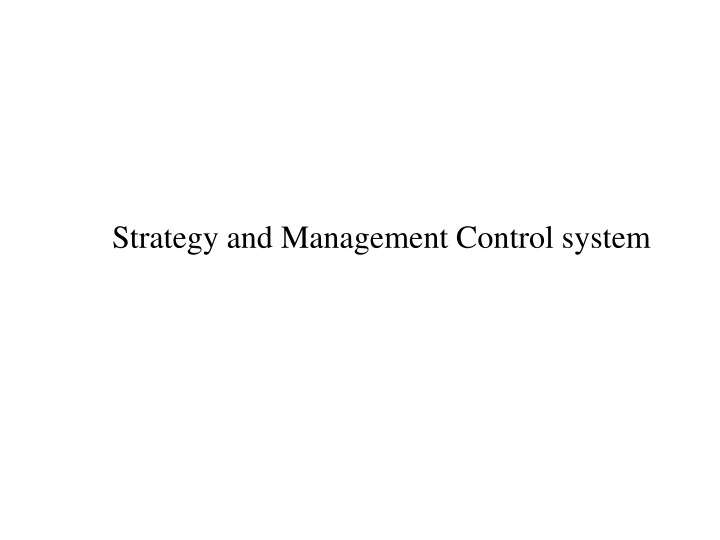Strategic Management and Business Strategy Overview
Explore the dynamics of strategy at various organizational levels, from corporate to business levels. Dive into corporate-level strategies like diversification and growth, analyze the BCG Portfolio Matrix, and make informed portfolio decisions. Understand business-level strategies such as differentiation and low-cost production to support corporate objectives effectively.
Download Presentation

Please find below an Image/Link to download the presentation.
The content on the website is provided AS IS for your information and personal use only. It may not be sold, licensed, or shared on other websites without obtaining consent from the author.If you encounter any issues during the download, it is possible that the publisher has removed the file from their server.
You are allowed to download the files provided on this website for personal or commercial use, subject to the condition that they are used lawfully. All files are the property of their respective owners.
The content on the website is provided AS IS for your information and personal use only. It may not be sold, licensed, or shared on other websites without obtaining consent from the author.
E N D
Presentation Transcript
Corporate Level Strategy What businesses are we in? What businesses should we be in? Four areas of focus Diversification management (acquisitions and divestitures) Synergy between units Investment priorities Business level strategy approval (but not crafting)
Corporate-Level Strategies Valuable strengths Concentric/Related Diversification (Economies of Scope) Corporate growth strategies Conglomerate/Unrelated Diversification (Risk Mgt.) Corporate stability strategies Firm Status Corporate retrenchment strategies Turn around/Divestment/Liquidation Critical weaknesses environmental opportunities Critical Environmental Status environmental threats
Growth share matrix/ Ansoff Matrix Organic/ Home grown growth In organic growth
The BCG Portfolio Matrix Market Share High Low Stars Question Marks ???? High Anticipated Growth Rate Cash Cows Dogs Low
Portfolio decision A B C Total Revenue 1 m 2m 3m 6.00 -Variable cost 0.2 0.5 1.5m (2.20) Contribution 0.8 1.5m 1.5m 3.80m -Fixed cost 0.9 0.9 0.9 2.7m Profit (0.1) 0.6 0.6 1.1m Product A in the portfolio has been making continues losses during last few financial years of the company. Advice whether the product A should be discontinued or not.
Business Level Strategy How do we support the corporate strategy? How do we compete in a specific business arena? Three types of business level strategies: Low cost producer Differentiator Focus Four areas of focus Generate sustainable competitive advantages Develop and nurture (potentially) valuable capabilities Respond to environmental changes Approval of functional level strategies
"Competitive Advantage: Creating and Sustaining Superior Performance." (1985)
Which do you prefer when you fly: a cheap, no-frills airline, or a more expensive operator with fantastic service levels and maximum comfort? And would you ever consider a small company with just a few routes?
Generic strategies Porter called the generic strategies "Cost Leadership" (no frills), "Differentiation" (creating uniquely desirable products and services) and "Focus" (offering a specialized service in a niche market). He then subdivided the Focus strategy into two parts: "Cost Focus" and "Differentiation Focus."
The Cost Leadership Strategy Porter's generic strategies are ways of gaining competitive advantage in other words, developing the "edge" that gets you the sale and takes it away from your competitors. There are two main ways of achieving this within a Cost Leadership strategy: Increasing profits by reducing costs, while charging industry-average prices. Increasing market share by charging lower prices, while still making a reasonable profit on each sale because you've reduced costs.
Driving cost leadership Access to the capital needed to invest in technology that will bring costs down. (Artificial Intelligence) Very efficient logistics. A low-cost base (labor, materials, facilities), and a way of sustainably cutting costs below those of other competitors.
The Differentiation Strategy Differentiation involves making your products or services different from and more attractive than those of your competitors. How you do this depends on the exact nature of your industry and of the products and services themselves, but will typically involve features, functionality, durability, support, and also brand image that your customers value.
To make a success of a Differentiation strategy, organizations need: Good research, development and innovation. The ability to deliver high-quality products or services. Effective sales and marketing, so that the market understands the benefits offered by the differentiated offerings.
The Focus Strategy Companies that use Focus strategies concentrate on particular niche markets and, by understanding the dynamics of that market and the unique needs of customers within it, develop uniquely low-cost or well-specified products for the market. Because they serve customers in their market uniquely well, they tend to build strong brand loyalty amongst their customers. This makes their particular market segment less attractive to competitors.
Choosing the Right Generic Strategy Combination of cost leadership and differentiation leads to confusion of competitive strategy Stuck in the middle (1985) Today context Hybrid strategy Cost Leadership requires a very detailed internal focus on processes. Differentiation, on the other hand, demands an outward-facing, highly creative approach.
Functional / Operational Level Strategy An example. Business L.S.: Become the low cost producer of widgets Functional L.S. (Mfg.): Reduce manufacturing costs by 10% Operational (Plant #1): Increase worker productivity by 15% Functional: How do we support the business level strategy? Operational: How do we support the functional level strategy?
A Simple Organization Chart (Single Product Business) Business Level Strategy Business Research and DevelopmentManufacturing Human Resources Marketing Finance Functional Level Strategy
A Simple Organization Chart (Dominant or Related Product Business) Corporate Level Multi business Corporation Business Level Business 1 (Related) Business 2 (Related) Business 3 (Related) Functional Level Research and Development Human Resources Manufacturing Marketing Finance
An example of an Unrelated Product Business (Note: By itself, an SBU can be considered a related product business) SBU: a single business or collection of related businesses that is independent and formulates its own strategy A Ex.: G.E. (General Electric Corp.) (Multi-business) Corporation Strategic Business Unit 1 S.B.U. 2 Company 1 Co. 2 Co. 3 Division 1 Div. 2 Div. 3























